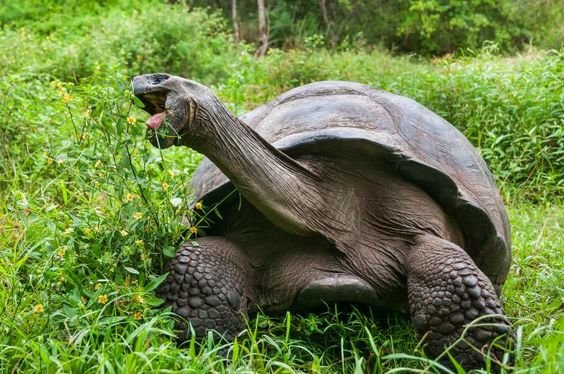
Understanding how the Aldabra giant tortoises eat and interact with their habitat gives insight into their role in the ecosystem. Here’s the thing: these tortoises are an essential part of their environment, helping to maintain the health of the landscape they roam. So, grab a cup of coffee, and let’s dive into the intriguing world of the Aldabra giant tortoise!
What Do Aldabra Giant Tortoises Eat?
Aldabra giant tortoises are primarily herbivores, munching on a variety of plant materials. Their diet consists of grasses, leaves, and succulent plants, with a particular fondness for the local vegetation. You might be wondering how they find enough food in their habitat, especially given the challenges of a tropical environment.
The Aldabra Atoll offers an abundance of grasses and leafy greens. During the rainy season, the vegetation flourishes, providing a hearty buffet for the tortoises. They particularly enjoy munching on the thick, juicy leaves of the pandanus tree and various types of shrubbery. It’s almost as if they have their own salad bar, where they can pick and choose their meals based on what looks tasty that day.
These tortoises can also eat fallen fruits and flowers. When the fruit is ripe and abundant, like the coconut or guava, it becomes a tasty treat that they happily indulge in. In fact, their ability to consume such diverse food sources helps them stay healthy and thrive in their unique environment.
The Foraging Behavior of Aldabra Giant Tortoises
Foraging isn’t as straightforward as it sounds. Aldabra giant tortoises have developed some interesting strategies to find food. Here’s how their foraging habits work.
1. Exploration: These tortoises can cover several miles in a single day while searching for food. They have excellent spatial memory that helps them recall the locations of food sources. It’s like they’re marking their favorite restaurants in their minds!
2. Social Foraging: Sometimes, the tortoises will forage in groups. When they do this, they can help each other locate food more efficiently. Picture a group of friends exploring a buffet together—all looking for the best dishes!
3. Grazing Techniques: Aldabra giant tortoises use their strong jaws to bite through tough plant materials. They can munch on grasses down to the ground, which helps clear the vegetation and encourages new growth. It’s this natural lawnmower behavior that maintains the health of the ecosystem.
Adapting to Seasonal Changes
The Aldabra giant tortoise’s diet changes with the seasons. The tropical climate makes for a rainy season when greens flourish and a dry season when food is scarcer. Here’s how these tortoises adapt to these changes.
During the rainy season, food availability is high. The tortoises can feast on a variety of plants, leading to a surge in their energy and overall health. However, as the seasons shift to the dry months, they face challenges. In this period, the tortoises still seek out food but might need to travel further to find it.
They may adapt by becoming more selective about what they eat. In the dry season, they will consume tougher plant materials that can withstand the lack of rain. Their bodies efficiently handle the limited food supply, showcasing their resilience and adaptability.
The Role of Aldabra Giant Tortoises in Their Ecosystem
You might not think of tortoises as big players in their ecosystem, but they are vital for their environment. Their foraging behaviors help shape the landscape and influence plant growth.
Their grazing habits promote biodiversity by helping certain plant species thrive while controlling the growth of others. This balance supports a variety of animals that depend on those plants for food and habitat. Think of the tortoises like nature’s gardeners, trimming and nurturing the vegetation around them.
Additionally, their droppings help disperse seeds. When they eat fruits and vegetation, they digest the nutrients but pass the seeds intact, planting new life as they wander. It’s a beautiful cycle that helps sustain the delicate balance of life on Aldabra Atoll.
Conservation Efforts for Aldabra Giant Tortoises
Despite their resilience, Aldabra giant tortoises have faced threats over the years, particularly from human activities. These majestic creatures are now a focus of conservation efforts aimed at protecting their populations and habitat.
Thanks to these initiatives, they’ve bounced back from near extinction. The Aldabra Atoll is a UNESCO World Heritage Site, which helps safeguard the tortoises and their ecosystem. Active monitoring and protection measures have been established to ensure their survival.
You might wonder how you can help. Supporting conservation organizations, promoting awareness, and visiting conservation-focused nature reserves are excellent ways to contribute to the ongoing survival of the Aldabra giant tortoise.
The Aldabra giant tortoise is more than just a fascinating creature to observe; it plays a critical role in its ecosystem and has developed unique strategies for foraging and survival. Understanding their diet and hunting methods gives us a peek into the complexities of nature and the importance of conservation.
So next time you see a tortoise, remember that they’re not just slow-moving animals; they are active participants in their environment, helping to shape it with every bite they take. Let’s protect these amazing creatures and the beautiful habitat they call home!
